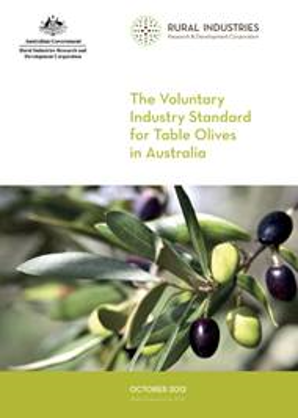02 Mar From the Agrifutures Australia Archives
This is a status report on olive R&D reports published from 2000 to 2013, currently available on the Agrifutures (previously RIRDC) website at: https://www.agrifutures.com.au/
- 16 reports identified for review and update
- 7 reports were identified as current and relevant as published.
- 9 reports were identified as obsolete or superseded
The AOA review of publications comprises a two-step process:
- Preparing a one page Review / Gap Analysis identifying those sections of the nominated publication(s) requiring revision / updating.
- Preparing an “Addendum” to update the nominated publication(s) that describes new developments / research outputs to be read in conjunction with the original paper.
This is the fourth of the review reports:
|
Download: Original Report October 2012: https://www.agrifutures.com.au/wp-content/uploads/publications/12-111.pdf Revised Standard January 2020: https://australianolives.com.au/wp-content/uploads/2020/02/RIRDC-12-111-Australian-Table-Olive-Standard-Kailis-Final.pdf
|
The Voluntary Industry Standard for Table Olives in AustraliaRIRDC Publication 12-111, October 2012 Author(s): National Table Olive Committee The Voluntary Industry Standard for Table Olives in Australia (the Industry Standard) has been prepared by the National Table Olive Committee (NTOC) of the Australian Olive Association Ltd (AOA). It is a voluntary industry standard that establishes an objective basis for the wholesale and retail trade of table olive products in Australia. The Industry Standard will ‘lift the bar’ for Australian table olive producers, in terms of improved product quality, food safety and productivity. The benefits to producers, wholesalers and retailers in having a clear objective industry standard will also deliver associated benefits to all consumers of Australian table olives. |
Review of the Voluntary Industry Standard for Table Olives in Australia
(RIRDC publication 12/111 – Updated January 2020)
RIRDC publication No. 12/111 Voluntary Industry Standard for Table Olives in Australia was reviewed and updated in January 2020 by one of the original authors, Professor Stan Kailis, making the following amendments:
- Foreword (updated – including new AgriFutures Australia contact details)
- Acknowledgments – About the authors (new), updated NTOC membership
- Executive summary (minor updating)
- Introduction (minor updating)
- Section 2 (minor updating)
- Section 3 (updated table 2)
- Section 4 (addition of seed oils and referencing the Australian Standard for olive oil AS5264-2011)
- Section 5 (updated table 4)
- Section 10 (minor updating)
- References (minor updating including current links)
The major amendment is expand the range of optional ingredients in Section 4 – Clause 4 to include olive oil and seed oils to bring the standard in line with current commercial practice:
Section 4: Optional ingredients
Other ingredients may be used such as:
- Water (potable or suitably treated to potable water standards)
- Food grade salts
- Vinegar – all food grades
- Edible oil – olive oil as defined in the Australian Standard® for olive oils and olive-pomace oils AS 5264-2011 (Standards Australia)[1], or other edible vegetable oils as defined in the Standard for Named Vegetable Oils (Codex Stan. 210-1999)[2], or in the equivalent Australian standards
Note 1: Edible oils with higher levels of polyunsaturated fatty acids will have lower oxidative stability and as a consequence a shorter potential shelf life. The oxidative stability of any edible oil used needs to be tested using Rancimat® and FAP analysis, and taken into account when determining the product Best Before Date (BBD)
Note 2: Where edible seed oils are used, the GMO status of these oils must be known and declared on the label.
Note 3: Where flavoured edible oils are used, the flavourings must comply with the requirements of point 8 below.
- Sugars
- Any single or combination of edible material used as an accompaniment or stuffing such as, for example, pimiento, onion, almond, celery, anchovy, capers, or pastes thereof
- Dried food-grade spices and aromatic herbs or natural extracts thereof
- Authorised food additives (including colourings and flavourings) (refer to Australia New Zealand Food Standards Code – Standard 1.1, and the General Standard for Food Additives (Codex Stan. 192-1995)[3]
Professor Stan Kailis PhD BSc(Hons) Dip Pharm Teacher Certificate (Tech)
Olive and Oil Specialist
Director – Australian Mediterranean Olive Research Institute
P: +61 (0) 414 27 1644
January 2020
[1] Australian Standard® for olive oils and olive-pomace oils AS 5264-2011 (Standards Australia): https://australianolives.com.au/australian-standard-5264-2011/
[2] Standard for Named Vegetable Oils (Codex Stan. 210-1999)
https://mvo.nl/media/voedselveiligheid/codex_standard_named_vegetable_oils.pdf
[3] General Standard for Food Additives (Codex Stan. 192-1995) http://www.fao.org/gsfaonline/docs/CXS_192e.pdf

